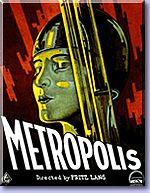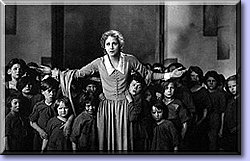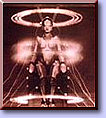|
Fritz Lang Biographie:
Birth Name: Friedrich Christian Anton Lang
Born: December 5, 1890, Vienna, Austria
Died: August 2, 1976
Education: Technische Hochshule (architecture); Vienna Academy of Graphic
Arts (art); School of Arts and Crafts, Munich (art); Academie Julien,
Paris Human Desire (1954), made during Fritz Lang's last decade as a
film director, begins with an emblematic image: a locomotive rushes
forward, swift and dynamic, but locked to the tracks, its path fixed,
its destination visible. Like Lang's films the train and the tracks
speak of a world of narrowly defined choices. The closing image is even
more severe: survivor Glenn Ford departs, his locomotive passing a sign
on a bridge. Ford does not see the sign, but we do; abbreviated by intervening
beams we suddenly see "The world takes" just before the film ends.
This vision of a hostile universe, constraints on freedom and messages
that are missed or misunderstood but always seen by someone, can be
found in all of Fritz Lang's films. His work has a consistency and a
richness that are unique in world cinema. In Germany, in France, in
Hollywood, then in Germany again, Lang built genre worlds for producers
and audiences and veiled meditations on human experience for himself.
Lang's vision is that of the outsider. James Baldwin, an outsider himself,
catches Lang's "concern, or obsession...with the fact and effect of
human loneliness, and the ways in which we are all responsible for the
creation, and the fate, of the isolated..." Born an Austrian, Lang fled
his training as an architect for a jaunt through the middle and far
east, returned to Paris just in time for the beginning of WWI, then
fought on the losing side of the war. Recovering from wounds which cost
him the sight in his right eye, Lang wrote his first scenarios: a werewolf
story which found no buyers, and Wedding in the Eccentric Club and Hilde
Warren and Death, which were sold and eventually produced by Joe May.
May's deviations from Lang's scripts motivated Lang to become a director
himself; his first movie was Halbblut/The Half-Caste (1919), a still-lost
film about the revenge of a half-Mexican mistress. Later that year he
directed the first film of a two-part international thriller called
The Spiders (1920). Part one, subtitled The Golden Lake, proved so popular
that his producers insisted Lang immediately make part two, The Diamond
Ship. He had been working on another script which he hoped to film,
so he reluctantly gave up The Cabinet of Dr. Caligari (1919) to Robert
Wiene. His contribution to that landmark film nevertheless was crucial:
Lang thought up the framing device, in which it is revealed at the story's
end that we have been watching a tale told by a madman, thus significantly
undercutting the audience's perceptions of the story.
Lang's career in the 1920s was one of spectacular rise to fame. With
each film, he became more assured, garnering critical acclaim as well
as a popular following. Dr. Mabuse the Gambler (1922), Die Nibelungen
(1924), Metropolis (1926), and Spies (1928) are among the greatest silent
films produced anywhere. Lang also made a remarkable transtition to
sound, with M (1931), but he ran afoul of Nazi authorities with The
Last Will of Dr. Mabuse/The Testament of Dr. Mabuse (1933), whose villains
mouthed Nazi propaganda. When the film was banned and Lang was requested
to make films for the cause of the Third Reich, he immediately fled
Germany, leaving behind most of his personal possessions, as well as
his wife, screenwriter Thea von Harbou (who had joined the Nazi party
and become an official screenwriter).
Lang made one film in France, then moved on to Hollywood, where he spent
the next 20 years working in a variety of genres, mainly thrillers (e.g.
Man Hunt, 1941, Scarlet Street, 1945, While the City Sleeps, 1956) and
some outstanding westerns (The Return of Frank James, 1940, Rancho Notorious,
1952). Tired of warring with insensitive producers, Lang left the U.S.
in the mid-1950s to make a film in India and then returned to Germany
for his last set of films, including a final chapter in the Dr. Mabuse
saga.
The disorienting frame in Caligari is an important part of Lang's distinctive
vision. His films are punctuated by shifts of viewpoint and discoveries
which transform the reactions of his characters - and of his audience.
The most obvious of these shifts of viewpoint come in Caligari and The
Woman in the Window (1944), in which the drama is suddenly revealed
to be a dream. But they also occur in the Mabuse films; in M, with the
policeman mistaken by a burglar for another thief; and in The House
by the River (1950), when a servant is strangled because another maid
appears to be responding to her cries for help.
Lang's films are also about contingency, the recognition that extra-personal
forces mold our lives, shape our destiny in ways we cannot predict and
only somewhat modify. In the two-part film, Die Nibelungen, Kriemhild
is transformed from a secondary figure in the first film (Siegfried)
into a whirlwind of fury in the second (Kriemhild's Revenge). Even the
characters in the film are shaken by these transformations. The king
of the Huns is staggered by Kriemhild's thirst for death; the vengeful
underworld in M that has captured and tried Peter Lorre is taken aback
by Lorre's confession that he "must" rape and murder, that he is something
of a spectator to his crimes.
These moments of perception are the foundation of Lang's importance
and continuing strength as a filmmaker. They constitute a kind of morality
that he never abandoned. In the script for Liliom (1934), his French
film made after he fled the Nazis, Lang wrote, "If death settled everything
it would be too easy...Where would justice be if death settled everything?"
Thirty years later, playing himself in Jean-Luc Godard's Contempt (1963),
Lang wrote for his character, "La mort n'est pas une solution." ("Death
is no solution"). Nor does death erase human striving. In Between Two
Worlds/Der Mude Tod/Beyond the Wall/Destiny (1921) the force of love
survives, in Fury (1936) the cycle of vengeance is broken, in Clash
By Night (1952) Barbara Stanwyck chooses reponsibility, in The Big Heat
(1953) Glenn Ford finally turns to the police and ends his vendetta,
and in Human Desire Ford again leaves the scene of the crime, choosing
life over the locus of death.
Biography from Baseline's Encyclopedia of Film

|
|


